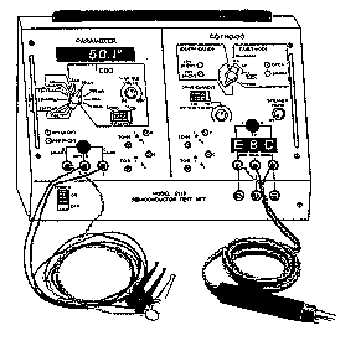2-10
to disconnect at least two transistor leads from the associated circuit for this test. Exercise caution during
this test to make certain that current during the forward resistance tests does not exceed the rating of the
transistor — ohmmeter ranges requiring a current of more than 1 milliampere should not be used for
testing transistors. Many ohmmeters are designed such that on the R 1 range, 100 milliamperes or more
can flow through the electronic part under test. For this reason, you should use a digital multimeter. Be
sure you select a digital multimeter that produces enough voltage to properly bias the transistor junctions.
Q-9.
When you are using an ohmmeter to test a transistor, what range settings should be avoided?
Transistor Testers
Laboratory transistor test sets are used in experimental work to test all characteristics of transistors.
For maintenance and repair, however, it is not necessary to check all of the transistor parameters. A check
of two or three performance characteristics is usually sufficient to determine whether a transistor needs to
be replaced. Two of the most important parameters used for transistor testing are the transistor current
gain (beta) and the collector leakage or reverse current (Ic).
The semiconductor test set (fig. 2-4) is a rugged, field type of tester designed to test transistors and
semiconductor diodes. The set measures the beta of a transistor, resistance appearing at the electrodes,
reverse current of a transistor or semiconductor diode, shorted or open conditions of a diode, forward
transconductance of a field-effect transistor, and condition of its own batteries.
Figure 2-4.—Semiconductor test set.
In order to assure that accurate and useful information is gained from the transistor tester, the
following preliminary checks of the tester should be made prior to testing any transistors.
With the POLARITY switch (fig. 2-4) in the OFF position, the meter pointer should indicate exactly
zero. (When required, rotate the meter adjust screw on the front of the meter to fulfill this requirement.)
When measurements are not actually being made, the POLARITY switch must always be left in the OFF
position to prevent battery drain.

